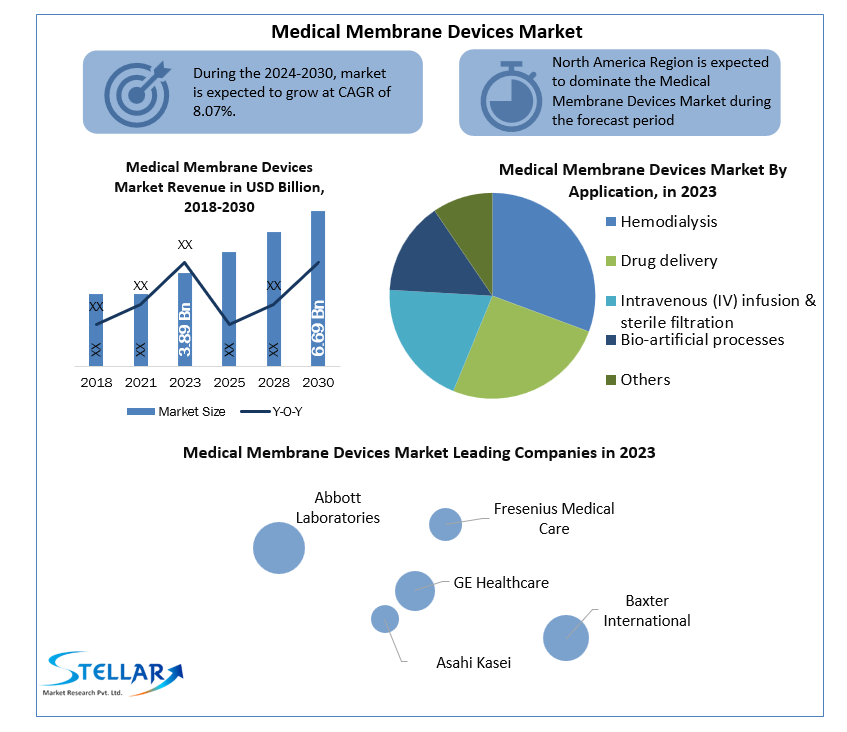Medical Membrane Devices Market Anticipated to Reach USD 14.2 Billion by 2030
Medical Membrane Devices Market Share is projected to grow from USD 8.5 billion in 2023 to USD 14.2 billion by 2030, exhibiting a Compound Annual Growth Rate (CAGR) of 7.5% during the forecast period.
Market Definition and Estimation
Medical membrane devices utilize semi-permeable membranes to separate substances at the molecular level, playing a crucial role in various medical applications such as hemodialysis, drug delivery, and bio-separations. The market's valuation in 2023 stands at USD 8.5 billion, with projections to reach USD 14.2 billion by 2030, driven by a CAGR of 7.5%.
Download your sample copy of this report today!https://www.stellarmr.com/report/req_sample/Medical-Membrane-Devices-Market/1511
Market Growth Drivers and Opportunities
-
Rising Prevalence of Chronic Diseases: The increasing incidence of renal diseases and diabetes has led to a higher demand for hemodialysis procedures, thereby driving the adoption of medical membrane devices.
-
Technological Advancements: Innovations in membrane technology, including the development of biocompatible and high-flux membranes, are enhancing device efficiency and patient outcomes.
-
Growing Healthcare Expenditure: Elevated healthcare spending globally facilitates the adoption of advanced medical devices, including membrane-based technologies, in healthcare facilities.
Segmentation Analysis
The medical membrane devices market is segmented based on material type, application, and region.
-
By Material Type:
- Polysulfone (PSU) & Polyethersulfone (PESU): Known for their thermal stability and biocompatibility, widely used in hemodialysis membranes.
- Polypropylene (PP): Utilized in membrane devices for its chemical resistance and mechanical strength.
- Polytetrafluoroethylene (PTFE): Applied in filtration devices due to its hydrophobic properties.
-
By Application:
- Hemodialysis: Dominates the market owing to the rising number of patients requiring dialysis.
- Drug Delivery: Membrane devices facilitate controlled drug release, enhancing therapeutic efficacy.
- IV Infusion & Sterile Filtration: Ensures the sterility and safety of intravenous therapies.
To access more details regarding this research, visit the following webpage:https://www.stellarmr.com/report/Medical-Membrane-Devices-Market/1511
Regional Insights
-
North America: Holds a significant market share due to advanced healthcare infrastructure and high prevalence of chronic diseases.
-
Europe: Experiences steady growth driven by increasing healthcare expenditure and adoption of advanced medical technologies.
-
Asia-Pacific: Expected to witness rapid growth owing to improving healthcare facilities and rising awareness about renal health.
Competitive Landscape
The medical membrane devices market is characterized by the presence of key players focusing on product innovation, strategic partnerships, and expansion to strengthen their market position. Notable companies include:
-
Baxter International Inc.: A leading global healthcare company offering a range of medical membrane devices, particularly in the renal care segment.
-
Fresenius Medical Care AG & Co. KGaA: Specializes in dialysis products and services, providing advanced hemodialysis membrane devices.
-
Nipro Corporation: Offers a variety of medical devices, including high-performance dialysis membranes.
-
Asahi Kasei Corporation: Develops innovative membrane materials for medical applications, enhancing device performance.
-
Toray Industries, Inc.: Engages in the production of advanced membrane technologies for hemodialysis and other medical uses.
For additional reports on related topics, visit our website:
RNA Analysis Market https://www.stellarmr.com/report/RNA-Analysis-Market-/1458
Malonic Acid Market https://www.stellarmr.com/report/Malonic-Acid-Market-/1459
Conclusion
The global medical membrane devices market is poised for substantial growth, driven by the rising prevalence of chronic diseases, technological advancements, and increasing healthcare expenditure. Companies investing in research and development, along with strategic collaborations, are well-positioned to capitalize on emerging opportunities in this dynamic market landscape.
